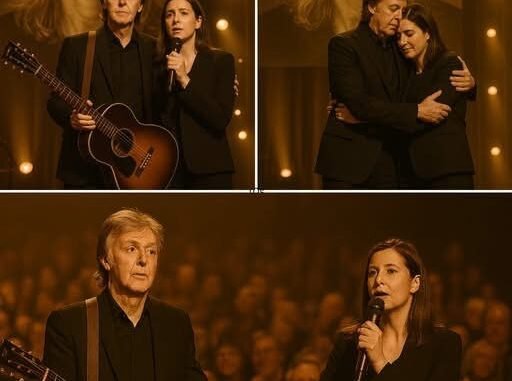
“For Linda”: Paul McCartney and Daughter Mary Deliver an Unforgettable, Heart‑Shattering Tribute at London’s O2 Arena
It began like any other stop on Paul McCartney’s sold‑out tour: bright lights, roaring cheers, and a setlist that had already taken the crowd through decades of history. But in an instant, everything changed. Midway through the show at London’s O2 Arena, the music fell silent, and the stage dimmed to a single white spotlight. McCartney, 82 years old but still commanding the room with the same quiet magnetism he had in 1963, stepped forward. Instead of launching into another hit, he rested his hands on the piano and looked out over the sea of faces.
“This next moment,” he said softly, “is for someone we all miss very much.”
The audience fell into a hush. And then, from the shadows, a familiar figure emerged: Mary McCartney, Paul’s eldest daughter, acclaimed photographer and filmmaker, walking toward her father with measured steps. Clutched in her hands was a single microphone. There was no backing band, no announcement, no spectacle—just a daughter joining her father onstage in front of 20,000 people.
Mary’s voice trembled as she spoke: “This is for Mum.”
What followed was less a performance than a communion of memory and love. Paul began to play the opening chords of The Long and Winding Road, his 1970 ballad steeped in melancholy and longing. But this time, the familiar song carried a weight no one in the arena was prepared for. As Paul’s voice floated over the piano, Mary joined him in harmony—fragile, tender, and raw. Their voices were not perfectly matched, and that was what made it devastatingly beautiful.
Behind them, the giant screens flickered to life. Instead of concert visuals, the audience saw old Super 8 reels and photographs: Linda McCartney laughing behind a camera, Linda cradling a young Mary on her hip, Linda dancing in the kitchen of their Sussex farmhouse. These were private images, never meant for the world, but here they were—Linda’s life unspooling like a hymn.
No one moved. Phones stayed in pockets, a rarity in today’s arenas. Strangers clasped hands. Some sobbed openly. The hush inside the O2 was so complete that even Paul’s foot on the piano pedal could be heard in the rafters.
Mary’s voice cracked on the lyric, “Many times I’ve been alone, and many times I’ve cried…” Paul glanced sideways at her, his eyes bright with tears, and nodded as if to say, It’s all right, love. Keep going. Together, they carried the song to its final refrain.
As the last chord lingered in the air, Paul turned to Mary, reached out, and kissed her forehead. He didn’t bow. He didn’t speak into the mic for effect. Instead, he leaned in and whispered, just loud enough for her to hear—but close enough that the front rows caught it: “She’s here.”
And in that moment, it truly felt as though Linda McCartney was there, filling the space between them, filling the silence that followed.
The crowd didn’t cheer at first. They couldn’t. There was only the sound of thousands of people trying to catch their breath, wiping tears, holding onto one another. Then, slowly, applause began—soft, hesitant, almost reverent—before swelling into something enormous, not a roar but a wave of gratitude, for the music, for the memories, for the courage of a family sharing their grief in the most public way imaginable.
For Paul McCartney, a man who has stood on the world’s biggest stages for over six decades, it was not about legacy or spectacle. It was about love. About honoring Linda, his late wife and creative partner, whose spirit has always hovered over his music. Linda was there when he wrote Maybe I’m Amazed. She was there on the farm when he recorded Ram in their kitchen, children laughing in the background. She was there in every quiet photograph she captured, and in every moment Paul chose family over fame.
For Mary, it was something even more personal. A chance to step into the spotlight not as a celebrity’s daughter, but as a grieving child, singing for her mother, standing beside her father, offering her voice as both tribute and healing.
When the show resumed, the energy was different—quieter, softer, yet more powerful. Paul moved on to Let It Be and Hey Jude, but the crowd was still lingering in that sacred space created minutes before. They hadn’t just witnessed a performance; they’d been invited into a memory.
In a career defined by countless iconic moments, this one felt unlike any other. There were no fireworks, no encores, no viral gimmicks. Just a piano, a daughter, a father, and the enduring shadow of a woman who shaped their world.
As the lights finally came up and people filed out into the cool London night, the conversations weren’t about the setlist or the production. They were about Linda. About the way Paul looked at Mary. About the way grief, when shared, becomes something beautiful.
It wasn’t just another concert. It was a love song—quiet, eternal, and, in that moment, the most powerful thing Paul McCartney has ever given the world.
Leave a Reply